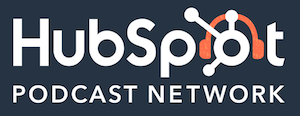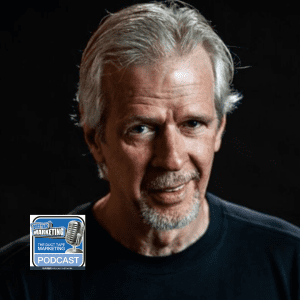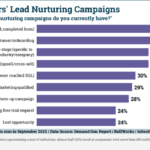Why Marketers Should Start Integrating AI Into Their Work
Why Marketers Should Start Integrating AI Into Their Work written by John Jantsch read more at Duct Tape Marketing
Marketing Podcast with Sam Garg
 In this episode of the Duct Tape Marketing Podcast, I interview Sam Garg. Sam is the Founder and CEO at Writesonic – an AI writer that helps you write SEO-optimized, long-form (up to 1500 words) blog posts & articles in 15 seconds.
In this episode of the Duct Tape Marketing Podcast, I interview Sam Garg. Sam is the Founder and CEO at Writesonic – an AI writer that helps you write SEO-optimized, long-form (up to 1500 words) blog posts & articles in 15 seconds.
![]()
![]()
Key Takeaway:
Artificial Intelligence is sort of like the human brain – our brain slowly remembers things we reiterate, picks up on similarities, notices patterns, and essentially creates new neural pathways in the system that is our brain over time. AI does just that, but at the speed of light. In this episode, I talk with the founder of Writesonic AI, Sam Garg, about AI today. Writesonic is one of the best AI writers out there today that helps you write SEO-optimized long-form content along with many other use cases. We talk about how AI isn’t here to replace the work we do as marketers. It’s here to work in tandem with us, making our work more effective.
Questions I ask Sam Garg:
- [1:17]What has your entrepreneurial journey looked like that led you to want to start Writesonic?
- [2:53] How do you hope to differentiate WriteSonic, particularly in the AI writing space?
- [4:12] When you’re talking to a complete novice and they ask how AI works – what’s your simple explanation?
- [5:34] So you talked about Writesonic being in the top tier of AI writers – what have you done from a marketing standpoint to gain traction with users?
- [6:18] Do you use Writesonic in all of your own marketing?
- [6:49] What are some innovative ways you see people using Writesonic outside of blog posts and landing pages?
- [7:44] What mistakes do you see people making when it comes to using AI technology?
- [9:04] What are some tips to get the best end product when using AI?
- [10:18] What are some of the end use cases really going to be with images in AI?
- [12:07] What technology is driving all of the image creation?
- [13:22] What does the future look like for AI in the next 3-5 years?
- [14:03] What do you tell a copywriter or an illustrator – are they gonna be out of work in three years or is there some way in which they need to participate strategically in using AI?
- [15:09] What’s coming for Writesonic in your roadmap?
- [16:03] Where can more people connect with you and learn more about Writesonic?
More About Sam Garg:
- Writesonic
Take The Marketing Assessment:
-
- Take the Assessment
Like this show? Click on over and give us a review on iTunes, please!
John Jantsch (00:00): This episode or the duct tape marketing podcast is brought to you by the nudge podcast, hosted by Phil Agnew and brought to you by the HubSpot podcast network. You can learn the science behind great marketing with bite size 20 minute episodes packed with practical advice from admired marketers and behavioral scientist. Nudge is a fast pace, but still insightful with real world examples that you can apply her recent issue. Talked about the, the idea of getting your customers or prospects in the habit of buying from you or listening to you or following you habit based marketing, download, nudge, wherever you get your podcasts. Hello, and welcome to another episode of the duct tape marketing podcast. This is John Jantsch and my guest today is Sam Garg. He is the founder and CEO at Wright Sonic and AI writer that helps you write longform blog posts and articles in 15 seconds. Quite a promise. We’re gonna dig into that. So Sam, welcome to the show.
Sam Garg (01:08): Thank you very much, John. Very glad to be here. I
John Jantsch (01:10): Always like to, you know, we talk, we’re gonna talk about your current product service company, but I always like to get a little bit of backstory on what, what is your entrepreneurial journey looked like that led you to, to want to start this company?
Sam Garg (01:22): For sure. Yeah. So I’m sort of like a software engineer by background. I’m graduated in 2019. And since I was like 12 years of age been building multiple different websites and apps. So I started building, you know, like simple websites, like personal websites and lots of other things possibly I’ve built like 10, 15 different micro startups as I like to call them or the last five, six years. And then what kind of started right? Sonic was like, whenever you’re promoting any digital product on, you need a landing page, right? Like if you’re not launching a product and, or hack a news, wherever you’re launching, you’d need a landing page. So that was the point pain point that I was having personally. So I wondered like, you know, how about I train an AI model that, you know, kind of learns from the copy of the top brands like apple and Stripe and CocaCola and all that. And then kind of writes the copy for me, cause I didn’t have any marketing or copywriting experience at that point. So that was the starting point. So I built it for myself. People started liking it and then yeah, we, we sort of grew and you know, we have a good amount of team members now and we’ve got some funding by Y Combinator and stuff.
John Jantsch (02:25): Yeah. It’s amazing how I bet you it’s 50% of the companies are started out there as somebody saying, well, I needed this thing for me and I couldn’t find it
Sam Garg (02:36): Exactly,
John Jantsch (02:37): You know, everything. Like I, I get, you know, these marketing emails from people all the time now, somehow they’re working AI into everything. Like, you know, it’s whether it actually uses AI or not. It’s kind of cool to say that it does. So it’s becoming a crowded space really. How do you hope to differentiate right. Sonic particularly in the AI writing space.
Sam Garg (02:58): Yeah, no, I mean, I get asked that question a lot, you know, there’s lots of companies in this space, you know how email marketing is right there. There was MailChimp and then there’s like hundreds of different companies now. So what I like to kind of say there is, you know, we were, I would say the second company who got started in this space and we are in the top three right now. Yeah. Our core strength is the AI background that I bring. And then the team members that we have there. So we are constantly experimenting with, you know, state of the art, AI models and our core strength is the product and the features that we build. So we have a very fast shipping speed every week. We are pumping new features out. Yeah. Lots of cool stuff there. Yeah.
John Jantsch (03:34): Yeah. I’m actually a user and I’m amazed by that. It’s like every time I go,
Sam Garg (03:43): Yeah. So we just launched photo signing. So that’s like, you know, generates digital art and images using AI. So that is one thing we are exploring very excited about that space. Yeah.
John Jantsch (03:51): That sure. That’s in its infancy, I think, but it’s certainly getting a lot of that, that idea, you know, especially with Dolly with open AI is really getting a lot of, uh, buzz these days. So we’ve only got a couple minutes for you to answer a question that probably would take hours to answer
Sam Garg (04:20): Yeah. So I mean, the way I like to think of it is, so AI is sort of like human brain, you know, it’s just like how a child learns when it sees, you know, when you were a kid, you would see images of things, you know, you would learn from there. Couple of times you repeat it, let’s say you’re kind of learning ABCD the alphabet. So you start with, you know, a, for apple and stuff. So you kind of, you reiterating it in your brain. Like you’re just remembering, and then slowly the brain picks up like the neural pathways become and you kind of pick up the patterns. So that is how sort of AI works. It’s sort of like this, you know, think of like this computer that sees something again and again and again, and then sort of picks up that pattern and it kind of gets edged and it’s kind of neural pathways on in its sort of like system. And then it is able to replicate that for any new scenarios or any new things that you throw it through at it. So, yeah.
John Jantsch (05:13): So I, and obviously I think that’s a good analogy, but you forgot the part where it does it a lot faster than human
Sam Garg (05:20): Much faster. Yeah, for sure. For sure.
John Jantsch (05:22): Yeah. So, so I like to tell people that I, it’s basically a computer that’s read everything and then is able to access everything and decide what, you know, what to bring back from that, you know, obviously at the speed of light. So you talked about right. Sonic being in the top, you know, top tier of particularly AI writers. What have you done from, uh, marketing standpoint to gain traction with users?
Sam Garg (05:43): Yeah, so, I mean, we have been trying a bunch of different things. So for example, EO has worked very well for us. You know, we an on the first page of Google for a lot of terms works very well and being a content focused company, we need to be good at content marketing and ATSU. Cause if we don’t do it, then the customers won’t trust us and they won’t kind of, you know, believe what we are building. So that’s one thing. We are also working a lot on social media. So Twitter, if you see there’s so many people making tweets and stuff about us now, influencers some PR and stuff as well. So lots of different factors that we tried.
John Jantsch (06:17): So that was really gonna be my next question. But I think you halfway answered it. Do you use right Sonic in all of your own marketing?
Sam Garg (06:23): We do. Yeah. So, I mean, if you check our landing pages, those are written by right. Sonic yeah. You check our blog. Most of them are written by right. Sonic with some, you know, improvements from humans. Like, you know, some fine tuning and some polishing, but yeah, we use it for everything.
John Jantsch (06:38): So you just mentioned blog posts and landing pages. What are some other ways that you see? I mean, you, I’m sure people are creating ads and social media tweets and you know, all that. What are some innovative ways you see people using it? And again, maybe you don’t, maybe you don’t really have access to the ways people, but maybe you’ve heard.
Sam Garg (06:56): Yeah. So I mean, apart from the 80 different use cases that we support, so people also tend to kind of mix and match different use cases. For example, we don’t have a book writing use case right now where you can, you know, just write a book, but people kind of combine different tools and people have written like eBooks and stuff. People have written songs and compose like, you know, proper lyrics and stuff and written that, or they have written like quite big like stories for children or stories in general. So lots of different use cases people are trying out for sure. And we are amazed to see things people are doing there. Yeah.
John Jantsch (07:28): Yeah. I bet writing an entire book. Now that that’s gonna be, that’s gonna be an interesting use case someday. Isn’t it. So on the flip side of that, what mistakes do you see people making when it comes to thinking about using, you know, AI technology?
Sam Garg (07:43): Yeah. So, I mean, there are some like set of people who think that, you know, AI can just do all of their jobs. So without them kind of doing any editing or kind of any thinking, it just would do everything for them. You know, it’s like a miracle, it just works and you don’t do anything. But whereas what we are kind of doing here is we are targeting ourselves as an sort of like a tool that helps writers that increases their productivity, right? So we come up with the first draft, that’s 80% there and then remaining 10 or 20% is where you add your own unique writing style or your unique sort of insights, and then improve that before you publish it out. Essentially.
John Jantsch (08:18): Now let’s hear from a sponsor, you know, today everybody’s online, but are they finding your website, grab the online spotlight and your customer’s attention with Semrush from content and SEO to ads and social media Semrush is your one stop shop for online marketing build, manage and measure campaigns across all channels faster and easier. Are you ready to take your business to the next level, get seen, get Semush, visit Semush that’s Semrush.com/go to try it free for seven days. Yeah. And that’s actually the way I tell people as well that, you know, don’t think of it as done. Just think of it as, as you know, you now don’t have to do the research. And so some of the grunt work, right? So, so the flip side of that, then, you know, what are some tips to get the best end product,
Sam Garg (09:08): The best ones, the best results that you get out of any AI model, whether that’s for image or text is when you give it good inputs, right? So the better the inputs, the better your outputs would be. So with these generative AI models, whether that is for text or image, the quality of the input sort of is directly proportional to your output. So the more in depth and like detail and very specific prompts or descriptions that you give to the AI, the better the text of the output would generate,
John Jantsch (09:36): Especially, yeah. I have found as a user that each step, if I iterate a little more, so if it gives me an introduction, you know, from a headline, I’ll actually edit that introduction a little bit. And then let’s say, I want five steps to do blah, blah, blah. I will actually probably edit each of those five steps. And I find that way I really get the best. So it really is kind of a four or five step process to get a blog post written. Isn’t it?
Sam Garg (10:01): Yeah, absolutely. I mean, it’s like you work together with the AI sort of like as an assistant. Right. And that’s where the magic happens.
John Jantsch (10:09): Yeah. Yeah. So, so talk a little bit about the images and the image product. How are you seeing, you know, right now I feel like it’s almost just a playground for a lot of people that, you know, they’re just going in and seeing, wow, it’s amazing. It did that, but what are, what are some of the end use cases really gonna be? I mean, do you see people actually creating images that they want for, or illustrations that they want for their websites that could go with their brand? I mean, how far do you think that the image creation can go?
Sam Garg (10:39): So yeah. I mean, it has come like a long way. Just lasted. If you were to kind of look at da or clip models, right. They were like, not there that the images were very bad, but just in the last two months, since da came and now stable diff fusion and mid journey, all these different models came up. Yeah. So the quality has improved by a lot where we are seeing the most amount of use cases, right. And of course the models are still developing, you know, every day the improvements are happening, but what, where we are seeing, uh, people using it is for stock images. So earlier where you would get it from Unsplash or these sites, same image, you can find on like a hundred different sites. Right. So there’s no personalization, there’s no kind of unique thing there. So now people can basically, we are even building this thing, right?
(11:20): So shutter stock and all these sites, they charge you like hundreds of thousands of dollars for one image. So what you can do is basically take the same description on that link. You put it in photo and it’ll give you a same image, like similar image for that same context, but it would be like hundred times cheaper than that. Yeah. So these are some of the use cases and then beauty, not beauty, like fashion and stuff like, you know, you have different clothes, so you can kind of try it out through the AI, you know, different combinations or furniture you can, you know, let’s say on Airbnb or something, you have a flat, like an empty apartment, but you want to show it fully furnished. So basically you tell the AI, you know, put a couch there, add some lighting and these kinds of things and to make it look very cool. And then that, that you can put on zoom plow all these platforms. So, so,
John Jantsch (12:06): So who’s driving or what technology is driving all of the, this image creation. So in other words, people talk about G P T three, you know, for the, you know, for the article writing. But so what’s driving the images.
Sam Garg (12:18): So images basically, there’s this technology called kind of latent diffusion where, you know, all these models, daily, stable diffusion, all of them are based on that.
John Jantsch (12:29): And Google also is very deep into, to, you know, their own image recognition. Aren’t they isn’t that a lot. What drives us?
Sam Garg (12:37): So not image recognition. I would say image recognition is sort of like a different space. Okay. But yeah, Google recently released this model called image gen that is sort of like similar to dally and it’s kind of doing a similar sort of thing. And
John Jantsch (12:50): Part of that, part of their rationale for that is, is for SEO purposes or for search purposes. Right. To be able to recognize what’s in a photo.
Sam Garg (12:59): Exactly. Yeah, exactly. Yeah. Everything is related to that for
John Jantsch (13:02): Google. Yeah, exactly. Some more ads somehow. Yeah.
Sam Garg (13:07): What’s
John Jantsch (13:07): Coming in AI in your view. I mean, a lot of people, you know, three, four years ago, it was still talked about almost like science fiction. Now people are seeing it every day or not even realizing that they’re experiencing it every day, but what’s so what’s out there three to five years from now.
Sam Garg (13:24): Yeah. So the, where the way we look at it is almost everything will have some sort of AI element in it. So right. Like last year kind of this whole AI writing industry blew up now it’s time for images and then next year it would be videos and then music and, you know, so sort of like all of these fields would sort of democratize by AI. Yeah. And yeah. So that’s what we see video probably in a couple of months or maybe an ear down the line, we’ll see videos also being made using AI, like movies and all sorts of stuff happening through AI, PowerPoint, presentations and everything. Basically we can see creative fields essentially coming up to,
John Jantsch (14:02): So what do you tell a creative, what do you tell a, a copywriter or an illustrator? Are they gonna be outta work in three years or is there some way in which they need to participate strategically in using AI?
Sam Garg (14:15): So yeah, that’s one thing that, that many people ask us. Sure. So the, a AI where it is at right now, it is not here to replace jobs is basically here to augment the, you know, the way that people work. So instead of, for example, for writers, instead of the AI, replacing them, it’s more like augmenting them. Yeah. And basically, for example, you know, freelancers, Lance writers, what they used to do in like one month with help from AI. Now they can do it in like one week. Yeah. Or even lesser like couple of days so they can get kind of more projects. They can make more money, they can kind of make more clients. So it’s a win-win for them as well if they kind of use it productively and in a good way. So that’s what we say.
John Jantsch (14:55): You know, I’m really advising, I coach a lot of marketing agencies and we’re, you know, we’re just telling everybody that will listen. You have to be using AI to become much more efficient with clients in the marketing space. I mean, it’s just a given what’s what’s coming for right. Sonic in the, in your roadmap.
Sam Garg (15:14): Yeah. So I mean, of course there’s the writing space. So right now we are focusing solely on blog and long form writing. Right. We do have 80 other use cases as, as well, but 80% of our users are using our blogging tools. Sosu and this is all that will be focusing on how can we produce very EO, optimized articles and blog posts that can be ran on Google easily. So that’s one thing. And then apart from that, as I mentioned, you know, we, we are right on, we are kind of experimenting with images and then next it’s coming for videos and then photo Sonic. So then video Sonic, and then we have kind of lyric Sonic or something and then slide Sonic for PowerPoints and stuff. So we are going to kind of explore all these different things where we can kind of the whole marketing pipeline or the whole pipeline we can sort of, you know, optimize using AI essentially.
John Jantsch (16:01): Awesome, exciting stuff. Well, Sam, thanks for joining the duct tape marketing podcast. You wanna tell people where, where they can find out more about right. Sonic and maybe connect with you even.
Sam Garg (16:11): Yeah, for sure. First of all, really glad to be here. Lovely chatting with you, John. Yeah. And, uh, yeah, so right, son, if you can find at right. so.com that’s w R I D E S O N I T. Right. so.com or you can just Google it and yeah.
John Jantsch (16:25): Awesome. Well, great. Hopefully we’ll, I’ll keep reaching out to you, Sam, just as I experiment with AI and with right. Sonic and hopefully we stay connected.
Sam Garg (16:35): Yeah. Awesome. Thank you very much, John. Really appreciate it.
John Jantsch (16:39): Take care. Hey, and one final thing before you go, you know how I talk about marketing strategy strategy before tactics? Well, sometimes it can be hard to understand where you stand in that what needs to be done with regard to creating a marketing strategy. So we created a free tool for you. It’s called the marketing strategy assessment. You can find it @ marketingassessment.co heck out our free marketing assessment and learn where you are with your strategy today. That’s just marketingassessment.co I’d love to chat with you about the results that you get.
Sign up to receive email updates
Enter your name and email address below and I’ll send you periodic updates about the podcast.
This episode of the Duct Tape Marketing Podcast is brought to you by the HubSpot Podcast Network and Semrush.

HubSpot Podcast Network is the audio destination for business professionals who seek the best education and inspiration on how to grow a business.
![]()
Everybody’s online, but are they finding your website? Grab the online spotlight and your customers’ attention with Semrush. From Content and SEO to ads and social media, Semrush is your one-stop-shop for online marketing. Build, manage, and measure campaigns —across all channels — faster and easier. Are you ready to take your business to the next level? Get seen. Get Semrush. Visit semrush.com/go to try it free for 7 days.









